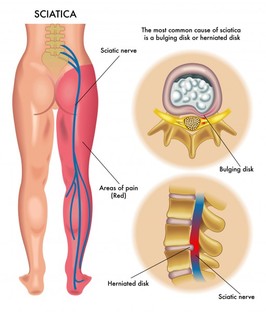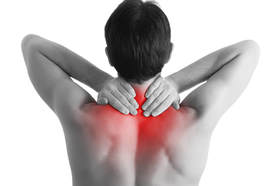|
Sciatica is the pain we experience when our sciatic nerve is irritated. The irritation can be caused by structures pressing on the nerve, such as a prolapsed disc, or inflamed muscle tissue.
Steve came to see me for help with his sciatica, after several sessions he recalls his experience with acupuncture, and how it helped him… ‘My GP recommended that I consider a course of acupuncture treatment after diagnosing me with sciatica and prescribing me codeine to help manage the pain, which was more intense than anything I’d ever experienced before in my life. Three days later I met Rachel, still bent-double with pain and struggling even to lever myself onto the treatment couch. She started by asking me a number of detailed questions about my condition; how had it occurred, where exactly was the pain, how painful was it, and so forth? Rachel also asked me what I knew about acupuncture - which was not a lot - and what I was hoping to achieve by the treatment? This detailed questioning was to characterise my whole experience with Rachel; she started every subsequent session with a review of what I had done since our last treatment, where the pain was now and how, if any, the pain had reduced? At our initial session, Rachel concluded that a mix of acupuncture and massage would optimise my chances of a speedy recovery, supplemented by a regime of daily walks; just a few steps at first, but eventually increasing to an hour a day. The massages were deep and intensive, but really relaxed my muscles. These were always followed by the acupuncture, with needles applied along the length of my right leg and lower back. I was pleasantly surprised that inserting the needles was virtually painless, merely the tiniest of pricks on occasions and sometimes I was even unaware that they had even been inserted. Rachel would then leave me for approximately 20 minutes for the needles to do their stuff, with the room darkened and some music playing softly in the background. I always found this very relaxing and on more than one occasion fell asleep; a real blessing, as I did not sleep well for the first month or so after my sciatica started. After each session, the pain was noticeably eased and I was able to walk more freely. Equally important, I also undoubtedly benefited emotionally from doing something positive to help the healing process. Within a couple of weeks I had stopped taking the codeine and all pain-killers after about a month. Over the course of the next 6 weeks, I had around one treatment per week on average and I am convinced they played an important part in my speedy recovery. I then went on a long-planned trips to the Maldives and whilst the 14 hour flight was not completely pain-free, it was far more comfortable than I could have ever imagined, further helped by some exercises which Rachel had recommended. Now, some 3 months after first developing sciatica, I am completely mobile, pain-free and exercising as normal, a great testament to Rachel’s expertise’. If you’d like to know more about sciatica, get in touch or for more information. Or take a look at my last blog. (Image courtesy of York Clinic)
2 Comments
What is Sciatica? Sciatica defines any pain that is caused by the irritation of the sciatic nerve. The sciatic nerve is the longest nerve in the body, it runs from the lower back (exiting in the lumbar part of the spine) through the buttocks and down the leg. It can affect different people in different ways, with pain ranging from mild and irritating to severe and debilitating. What are the Symptoms? Typically, sciatica only affects one side of the body. You may experience any of the following symptoms in your buttocks, down your leg or even your toes:
What causes Sciatica? Nerves exit the spine via nerve roots in between the vertebrae. A group of nerves in the lower back merge to form the sciatic nerve. Sciatica occurs when something is pressing or rubbing the nerve as it exits the spine, such as:
How can it be treated? General treatment for sciatica includes prescription painkillers specifically for nerve pain, and combination of gentle exercises and stretches. It also advised that where possible to carry on with your day to day activities. How Acupuncture can help: Acupuncture helps to relieve sciatica by:
It also has an effect on the nervous system; when the needles are inserted, local nerves stimulate the release of endorphins and other neurotransmitters. These change how the brain and spinal cord processes pain, explaining how pain is reduced. Over the past few months there has been an increasing amount of people seeking relief for their sciatica. We have found that most patients respond well to acupuncture, both for relief from the acute pain and in helping to manage and resolve their sciatica. Find out how acupuncture helped Steve, in the next blog. Tips for keeping back pain at bay:
If you'd like to talk more about how acupuncture could help you, get in touch. Thanks for reading! What are those painful and annoying “knots” in our muscles and how can we manage them? Although it is common for us to experience the uncomfortable sensation of tight muscles, it doesn’t make it normal. Bands of hardened muscle usually hold within them extremely tender spots, which can bring about local pain and referred pain (a pain that is felt in a part of the body which if different that its origin). These spots are known as “myofascial trigger points” or TrPs A TrP is made up of many so-called contraction “knots”. It can become quite complicated as to why these knots occur, and there has been confusion over their cause, but it appears that researchers have come to a general consensus. The knots are thought to be caused when individual muscle fibres are shortened and become permanently contracted, hence, contraction knots. Although these individual knots are relatively small, they can be painful and problematic. When the small contractions knots pull on the surrounding muscle fibres, this generates small taut bands of muscle. Some are “active” TrP and are always tender and when pressed refer pain elsewhere. TrPs in the neck or shoulder can cause:
A Trp can also be “inactive” or latent, these are only tender when palpated, this can be why patients don’t realise it’s there until we find them. What Causes TrPs? There are a variety of factors that can cause these painful TrPs to occur such as:
Care advice and prevention: If left untreated the pain can persist and could become more of a chronic condition, which in the long run will take longer to heal. In essence what we need to do is to increase lymphatic drainage, circulation & blood flow to the area, which will bring in fresh oxygen and take away waste products. If you act early, you may be able to treat yourself at home with techniques such as:
If the pain persists or you feel it is getting worse then there are other options for you:
Something called “muscle memory” means that when muscles have become tight for whatever reason, they learn to stay tight. As with any treatment, be it self-care or with a professional, the key is consistency. TrPs will eventually release if you keep going. Tips to keep TrPs at bay:
If you have any questions about this blog or anything else let me know, thanks for reading! 07906 306228 rachelhemblade@gmail.com {Image courtesy of http://www.southcountyhealth.org/ ] |
AuthorRachel Hemblade Archives
February 2023
Categories |
|
|



 RSS Feed
RSS Feed
